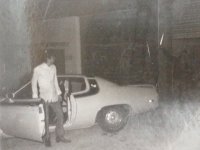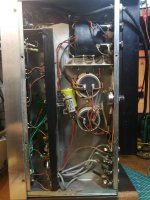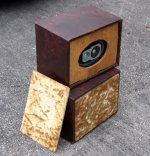OMG! The clothes!
I used to look like that too!
It's neat that someone took some pictures and that you still had them. Ever cool.
So which one of you had brown pants after that? Why didn't the spark jump from the leads to someone's hand? You guys were so lucky!
My idiotic trick was to replace blown fuses in 550 VAC lighting controller cabinets in the dark with bare hands. The house light fuses would sometimes blow in a new high school. I was a "minor niner" the second year it was open, then Sound and lighting club president two years after that. Oh, the stories I won't tell.
-Chris
I used to look like that too!
It's neat that someone took some pictures and that you still had them. Ever cool.
So which one of you had brown pants after that? Why didn't the spark jump from the leads to someone's hand? You guys were so lucky!
My idiotic trick was to replace blown fuses in 550 VAC lighting controller cabinets in the dark with bare hands. The house light fuses would sometimes blow in a new high school. I was a "minor niner" the second year it was open, then Sound and lighting club president two years after that. Oh, the stories I won't tell.

-Chris
So which one of you had brown pants after that?
I was the only person stupid enough to hook this thing up. When the big bang happened and I had stopped shaking, I got up and walked out of the shop, and drove home, about an hour ride. I'm the idiot who has half the transmitter in his lap and my head stuck inside it. Jeans or jean shorts, flip flops and a blue work shirt or solid color T shirt was my usual dress for those days. The other two were high school friends. The guy who ran the shop was nowhere around. He had offered me $100 in 1776 money to get a 3KW transmitter operational on Citizens Band!
It's neat that someone took some pictures and that you still had them. Ever cool.
The guy who ran the shop was also a high school friend. He took the pictures....before I got power wired to the unit. I had forgotten about this stuff until I was at his house a few years ago and we were looking through some of his old photo albums. Many were the usual boring stuff, some involved acts of stupidity committed in automobiles, and of course lots of pyrotechnics. I took some pictures of his pictures with my phone, that's why the quality is bad.
I also wired up a 1 KW transmitter in the trunk of his car. I am the dark figure in the shadows holding a fluorescent light tube that's lit by the RF coming off that whip antenna.
From 1974 to 1984 I was responsible for factory floor maintenance of most of a Motorola plant on the evening shift. There were lots of deadly toys to play with including a 100 watt CO2 laser, to which I had applied my tweaks to get almost 200 watts out of. This involved bypassing a saturable core reactor in the high voltage power supply to boost the 22 KV supply to somewhere beyond the end of a 25 KV meter. This machine scared everybody including me.
The "best bang" award goes to a young eager setup tech who ran the vapor deposition machine. This sputtered copper, nickel, or gold onto ceramic substrates used in the MX300 police radios. It ran on 480 volts 3 phase and had a propensity for popping the 20 amp 480 volt fuses. When this happened I would grab a Fluke 8000 or Kontron digital meter put it on AC volts and touch the probes across all the fuses in the row in the fuse panel. The fuse with voltage across it was the dead one. I would hot swap the fuses with plastic pliers, reboot the machine and go on my way.
One day there was a loud bang, some screaming and smoke coming from the room. As I got there Mr. Setup Tech was walking out of the room with a Kontron meter in which parts exploded so violently that some came through the metal case. He had tested the fuses with the meter on OHMS!
Attachments
A mint condition BGW 300 amp for $35 on my way home from work. Haven’t been able to find a schematic, but it’s very close to a 250. I’ve changed the decoupling arrangement for the op amps, and the input/feedback caps, is sounding very good.
Also found a Nakamichi PA5 for $50 just now, but will have to let that one go to someone else, is a longer drive.
Very Cool !!!
Does it have the led bargraph display?
I picked up mine (250) in the 90's for $80 and I managed to get a copy of the service manual from BGW just before the sold the company.
It may be able to be found on the net, I will look for the PDF, I might have it.
Else I will have to scan it, I need to find it anyhow because one of my channels went wonky and finally died.
It has served me well for many many years, very simple circuit to understand, in fact it is my all time favorite configuration for an amp.....Easy to duplicate !! 🙂
Cheers !!

jer 🙂
This old PA amp. Check that heatsink and transformer out. It is right now basically an oscillator, so these guts will have to go, but the outputs must be good at least. I might use this as a chassis for the Archosaurus (those 2n3055 are there ready to go!), or something along those lines. Cost $1.50 ... worth it for the heatsink alone but check the "retro charm" with the yellow inlay [emoji8][emoji108] it even has a built in monitor speaker and VU meter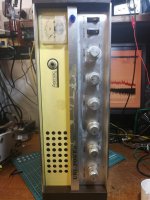
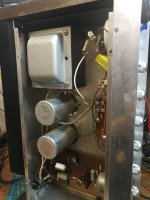
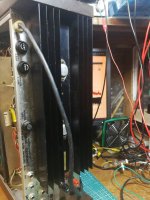



Nice score for $1.50!! 🙂
Today I bought an oxygen sensor for my car and a paintless dent removal kit.
Tony.
Today I bought an oxygen sensor for my car and a paintless dent removal kit.
Tony.
Boy, do those pictures take me back! In the early '80's I used to work at an AM station in the middle of a cornfield. The interior looked almost exactly like the room in your pics, right down to the carpet (except we had vomit-yellow shag carpet on the walls of the control room - ugh...). I spent a lot of idle hours ignoring the station's format, smoking cigarettes, and staring into the angry eyes of the huge red RCA BTA-5T transmitter that was visible through a plate glass window to the right of the console. That thing scared the living hell out of me, mainly because it was old and decrepit, but also because the chief engineer had defeated every safety interlock he could get his hands on....3 KW Gates transmitter...
During a thunderstorm one night, one of towers was hit by a bolt of lightning just as I was switching the transmitter to low power. About all I remember of that instant was a loud *crack*, a large puff of smoke, and running like crazy through the transmitter room door (squirting urine with every step!).
Once the excitement had died down I called the engineer and helped him survey the damage. The lightning strike killed the transmitter, all three transmission lines, and the mixing console. The console was actually a blessing as it was an old Ramco Research unit that everyone hated with a passion, but the transmitter's violent death meant most of us would have to find other work (to keep us in cigarettes and beer) until the station limped back on the air.
Thanks for the memory!
And lest I forget, I purchased a long-needed haircut today...
No matter how much we think we change, there's no doubt who's in that first pic with your head inside that 'furnace'.I'm the idiot who has half the transmitter in his lap and my head stuck inside it.
Accidently 🙂headbash🙂 managed to wind two bids on vintage cameras.
One was the Italian Bencini Comet (got one with broken shutter - will be turned into a lamp) and an Italian Ferrania Ibis 44.
Both aimed for 127 roll film, but I got some rolls and am adjusting the backing paper from 120 film to suit the 127-rolls in order to use 135 film.
The headbanger is due to the fact I had to pay a $200 fee for speeding a few weeks ago and I am very close to red figures on my bank account ....
Oof. Hobby<some cash on hand. Be careful brother!
AM station in the middle of a cornfield. The interior looked almost exactly like the room in your pics
That place was actually a warehouse where the bean bag chair and waterbed factory next door stored their raw material. Two units down was a shop that sold ham radios, CB radios, and "boosters" for both. Their repair shop was in the office area of the bean bag warehouse.
Their repair tech was a high school friend who was in the vocational electronics program with me. That was where I first learned to melt tubes. He was a decent tech, but somewhat slow. When the backlog got too big my friend with the camera and the Road Runner would call me to catch them up, for $10 per radio, in cash. I fixed radios from early in the morning until the cash ran out.
Then there was the Gates, and the $100 offer to make it work. You would think that 3 KW on CB frequencies would get someone arrested, but they ran that thing for over 2 years. They even had a DJ from a local radio station adding to the insanity. I refused to be there when they were on the air, but I could hear them from my apartment 40 miles away.
The bean bag and waterbed shop gave me an opportunity to cash in on something almost as insane as CB radio......DISCO. Yes, shag on the walls in a radio station was nothing compared to shag, Naugahyde and crushed velvet on speakers and inside my van!
I didn't want to be associated with Disco, so no pictures exist, except for the pair of small speakers I found in my warehouse when I was preparing to move. These were used to ROCK the beach in Dania Florida from the roof of my 1965 Dodge Dart. I found them, took these two pictures, plugged them into a guitar amp and scattered that 40 year old foam surround all over the driveway!
OH, yeah, the experiments with my new hot air rework station were successful. I took several dozen parts off of some dead boards without burning anything. Not a bad deal for $100.
Attachments
Hey George - on ohms ??!
I guess that explains why it is an ex-meter now. High voltage has the awesome power to create open circuits from objects you were certain could stand up to it. I don't think they actually stress that in electronics courses enough where the energy goes up as the square of the voltage. I discovered this factoid out with some large power resistors trying to discharge a power supply before I went to work on it. It was just a Conrad Johnson Premier one amplifier. The damage to the resistor was impressive on the inside. It was one of those units with the ribs around the body and the flat mounting area with four screws. It went "pop" when I connected it, and discovered that the voltage was mostly still there by measuring again. By this time it was well ingrained to actually check things and make on assumptions. That resistor measured open, it was a 50 watt unit I think. Imagine finding that resistor open! It was about 100 ohms.
-Chris
I guess that explains why it is an ex-meter now. High voltage has the awesome power to create open circuits from objects you were certain could stand up to it. I don't think they actually stress that in electronics courses enough where the energy goes up as the square of the voltage. I discovered this factoid out with some large power resistors trying to discharge a power supply before I went to work on it. It was just a Conrad Johnson Premier one amplifier. The damage to the resistor was impressive on the inside. It was one of those units with the ribs around the body and the flat mounting area with four screws. It went "pop" when I connected it, and discovered that the voltage was mostly still there by measuring again. By this time it was well ingrained to actually check things and make on assumptions. That resistor measured open, it was a 50 watt unit I think. Imagine finding that resistor open! It was about 100 ohms.
-Chris
Or in the case of my last bench meter, HV had the power to create short circuits where you thought it could stand it. (950VAC rated only for 750VAC).
Hey George - on ohms ??!
The setup tech were given specific training, and operations manuals for dealing with machines that cost say $150K in 1975 money. In this case the textbook approach which the tech should follow was to shut down the machine which meant venting the chamber, and releasing the vacuum / gasses which were present, and often spoiling the lot of parts being processed. Once the machine was returned to idle state, all the breakers in the panel were shut off, then the tech would verify that the fuse panel was dead, then test the fuses with an ohmmeter and replace the dead one. After that a lengthy start up / hi vacuum pump down cycle was needed.
This made sense from a safety perspective since the setup techs often knew little about electricity and safety. They were not permitted to do anything on the machines that wasn't in the book. Only authorized service people like myself were supposed to open the "door." The breaker panel was like any other with no exposed electricity. The fuse panel however was behind a GROUNDED METAL door and had open cartridge fuses with exposed wiring for 120, 240 and 480 volts. Not something to play with.
This machine ran 24/7 and was one of the bottlenecks in the production of parts for the radio factory. The fuse that often blew was one of three in the vacuum tube based "RF power supply" which was basically a 1.5 KW radio transmitter on 27 MHz that created giant controlled plasma balls inside a huge vacuum chamber. The fuse blew, because like the laser, they were asking more power from the machine that it was designed to make. Lightning could strike 5 miles away, and "Captain Nemo" as the machine was called would pop a fuse.
The dumm blonde one had developed a "short cut" that I could use to save the lot of parts from scrap and eliminate the lost time to vent and pumpdown. I would suspend the process, and swap the fuse live, then reboot only the RF power supply and restart the lot from where it was. Myself and one other support tech would dare do it.
At least you guys didn't just make the fuse larger to prevent the "nuisance" tripping... I'm waiting for an order of "sloblo" fuses, but right now, I'm using 8A fuses for a 3A circuit so they survive inrush.
At least you guys didn't just make the fuse larger to prevent the "nuisance" tripping
I think someone tried that once. Those fuses were rather large and only came in a few sizes. I remember that Nemo used 20 amp 600 volt fuses. I don't remember what the next biggest size was but it was a significant jump, 30 amps I think. There was a possible event that could occur under certain kinds of misadjustment that would blow the fuse. An oversized fuse resulted in a week of downtime for a new RF power supply.
Flu shot in one arm, Shingles booster in the other. Shingles arm is sore as hell. Hope this stuff works.
An Asus Xonar SE sound card. Promises high SNR (110dB input, 116dB output) and resolution (24-bit 192kHz) for a very reasonable price.
Should allow me to perform more accurate measurements than the el-cheapo USB sound card thing I've been using.
Should allow me to perform more accurate measurements than the el-cheapo USB sound card thing I've been using.
Hi leadbelly,
-Chris 🙂
Yeah, I know. We heard it all the way over here!Wallet squeaked open for a $12 self adjusting stripper from Cdn Tire.
-Chris 🙂
- Home
- Member Areas
- The Lounge
- And what did we buy today?
